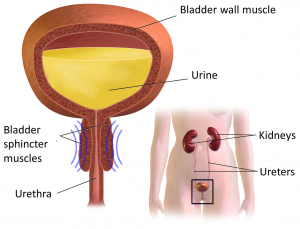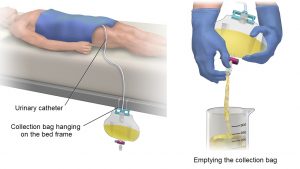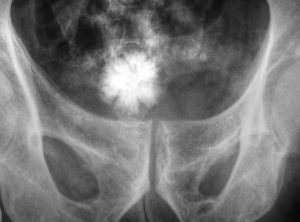Author: SCIRE Community Team | Reviewer: Bonnie Nybo | Published: 24 October 2017 | Updated: ~
Urinary catheters are a common method of emptying the bladder after spinal cord injury (SCI). This page provides basic information about the use of catheters for bladder problems after SCI.
Key Points
- Urinary catheters are pieces of equipment that are used to drain urine from the bladder for people who experience bladder problems after SCI.
- There are several ways of using catheters, including intermittent catheterization (a catheter that is inserted and removed from the bladder several times each day), indwelling catheters (a catheter that is inserted into the bladder and remains in place), and condom catheters (external catheters that cover the penis).
- Urinary catheters may have risks with their use, such as damage to the urethra, bladder stones, and urinary tract infections.
- Choosing a type of catheter to use and developing a bladder management routine should happen together with your health team based on the type of bladder problems you have and your risk of complications, ability to use the equipment, and personal preferences.
- Catheters are an essential standard treatment for emptying the bladder after SCI. The research evidence suggests that intermittent catheterization is associated with the lowest risk of complications after SCI, followed by condom catheters, and then indwelling catheters.
Urinary catheters (simply referred to as ‘catheters’ on this page) are pieces of equipment that are used to drain urine from the bladder
Most catheters are thin tubes that are inserted directly into the bladder through the urethra (the duct that leads urine out of the bladder), but can also be placed outside of the body in males (condom catheters). These tubes allow urine to drain out of the bladder into a collection device such as a collection bag. There are several different types of catheters that are available, including single-use catheters and lubricated (hydrophilic) catheters.
Urinary catheters are used after SCI to help drain urine from the bladder in those who have difficulty emptying the bladder due to neurogenic bladder.
Many people experience bladder problems after spinal cord injury. SCI can lead to a loss of coordination between the brain and bladder, which can lead to irregular draining and filling of the bladder known as neurogenic bladder
There are two main types of neurogenic bladder, which may involve either a bladder that does not have the reflexes to empty itself (flaccid bladder) or a bladder that has unpredictable reflexes that cause it to empty (spastic bladder). Neurogenic bladder can lead to leaking of urine, incomplete emptying, and overfilling of the bladder, which can stretch and damage the bladder and kidneys.
Urinary catheters are the main technique that is used to allow for bladder emptying in people with neurogenic bladder after SCI.
Complications of poor bladder management
Regularly draining the bladder is a very important part of taking care of the body after SCI. Several serious complications can happen if bladder management is not successful:
• When the bladder is not emptied regularly, it can continue to fill and may back up into the kidneys, which can cause damage to the kidneys.
• Overfilling of the bladder can also trigger a dangerous blood pressure response in some people with injuries at T6 and above called autonomic dysreflexia.
• Poor bladder management can contribute to urinary tract infections, which, in severe cases can lead to a life-threatening blood infection called sepsis.
• Leakage of urine can also contribute to the development of pressure sores, which can also be susceptible to dangerous infections.
There are several different types of catheters that may be used for bladder problems after SCI. The type of catheter chosen depends on the type of bladder dysfunction that you have (i.e. flaccid bladder or spastic bladder), as well as other factors like other health conditions, your self-care routines at home, level of independence, funding and lifestyle. It is important that you discuss your unique situation with your health providers to find the best treatment options for you.
Intermittent catheterization
The most common method of emptying the bladder after SCI is intermittent catheterization. Intermittent catheterization involves inserting and removing a catheter into the bladder through the urethra on a regular schedule during the day (usually every 4 to 6 hours) to drain urine from the bladder.
 The timing of intermittent catheterization is important. Maintaining a regular schedule of bladder draining can help to prevent urine leakage and bladder overfilling. Your unique bladder schedule will depend on the type of bladder dysfunction you have and other factors like fluid intake.
The timing of intermittent catheterization is important. Maintaining a regular schedule of bladder draining can help to prevent urine leakage and bladder overfilling. Your unique bladder schedule will depend on the type of bladder dysfunction you have and other factors like fluid intake.
Depending on the situation, intermittent catheterization may be performed by you, a caregiver, or a health provider. There are many different techniques that may be used to insert the catheter depending on level of hand function and whether you are a male or female.
However, it is very important for all individuals to maintain good hygiene each time intermittent catheterization is used, which includes washing your hands and genitals before inserting a new single use catheter and thoroughly cleaning and drying (moisture attracts bacteria) if reusing your catheters. If funding allows – reusing catheters is not recommended.
Indwelling catheters
Indwelling catheters (or Foley catheters) are tubes that are inserted directly into the bladder and remain in place to continually drain urine from the bladder.
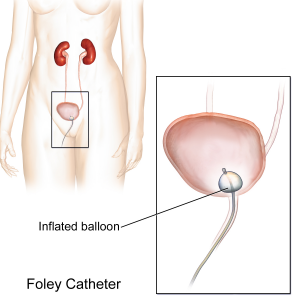
An indwelling (Foley) catheter is inserted through the urethra and held in place in the bladder by a small balloon.4
In most cases, indwelling catheters are inserted in through the urethra and into the bladder (known as urethral catheters). Once in the bladder, the very end of the catheter has a small balloon around it, which can be inflated to hold the catheter in place.
Indwelling catheters can also be inserted through a surgically created hole through the abdomen just above the public bone into the bladder called a stoma. These are called suprapubic catheters. Suprapubic catheters may be recommended as a later option for people who have medical complications or other reasons that make it difficult to use urethral catheters, such as intimacy.
Indwelling catheters may be used as a treatment option for people who are not able to insert a catheter regularly to perform intermittent catheterization, to allow for constant drainage of the bladder, and for people who have too much leaking of urine between uses of intermittent catheterization. Indwelling catheters are typically changed and replaced using sterile technique about once per month. Securement straps are recommended to secure indwelling catheter tubing as well as urine drainage bag tubing.
However, there are risks of having a catheter in the bladder all the time, such as increased risk of infections, sediment and bladder stones.
Condom catheters
Condom catheters are catheters that are placed over the penis on males to collect urine. Condom catheters resemble a condom and are placed over the penis and connected through tubes to a collection device. Unlike indwelling catheters, condom catheters must be changed each day.
Condom catheters are usually used for people that either leak in between bladder emptying sessions or for individuals who have the ability to trigger emptying by causing a spasm of their bladder (called reflex voiding). Because they are used to collect urine as it passes out of the body rather than directly from the bladder, condom catheters are not usually used for people with difficulties causing the bladder to empty.
One of the main concerns of condom catheters is incomplete bladder drainage, which can cause kidney damage. Therefore, a careful medical examination is needed to ensure that use of condom catheters alone is an appropriate management technique. For people who can use them safely, condom catheters are often considered a safer long-term treatment option because they are less invasive than catheters that are inserted into the body.
Reflex voiding
Reflex voiding is a technique that can be used by some people with spastic bladder to cause urination. Reflex voiding is usually done by tapping over the bladder lightly and repeatedly with the fingertips or the side of the hand to stimulate reflex muscle contractions in the bladder that cause urination. This technique can be used to help improve bladder emptying during intermittent catheterization and when using condom catheters.
Older techniques for reflex voiding such as the Valsalva maneuver (increasing abdominal pressure by holding the breath and bracing) and the Crede technique (applying manual pressure onto the bladder through the abdomen) are NO longer used because they can cause too much pressure in the bladder, which can damage the kidneys.
Maintaining good hygiene
Maintaining good hygiene and cleanliness is required when using all types of catheters. In addition to washing your hands and genitals before using catheters, it is important to clean the collection bag as well. The collection bag must be emptied once it is about ¾ full. This is essential to help prevent complications like infections and the weight of the bag causing the condom catheter to fall off or irritation to the urethra if using an indwelling catheter.
Although sterile technique (using medical grade techniques and equipment to reduce bacteria) may be used during catheterization, research suggests that clean technique (maintaining clean and hygienic, but not medical grade techniques) is sufficient to reduce risk of urinary tract infections.
Although use of urinary catheters is the standard of care for managing bladder emptying after SCI, there are risks and side effects that may be related to the use of catheters. This is not a complete list. Speak to your health provider for further information.
Risks and side effects of urinary catheterization may include:
- Pain and discomfort
- Inconvenience
- Indwelling catheters may limit a person’s movement and activities
- Indwelling catheters may be considered embarrassing
- Damage to the urethra from insertion of catheter or irritation from excess movement of indwelling catheter
- If used improperly (not regularly enough), damage to the kidneys can happen when bladder overfilling or bladder pressures causes urine reflux back up to the kidneys
- Allergic reaction to the catheter material (often latex)
- Bladder stones (crystallization of minerals in the urine from poor bladder emptying, indwelling catheters and unclean catheterization technique)
- Urinary tract infections (from unclean catheter technique and incomplete bladder emptying)
- Bladder cancer is associated with long term use of catheterization
Some of the risks associated with using urinary catheters can result from improper use, such as using improper or unclean technique or waiting too long between catheterizations. It is important that you discuss your bladder routine with a knowledgeable health provider to determine the best schedule for you and to learn to use the equipment correctly.
The use of urinary catheters for emptying the bladder is considered an essential standard care for bladder problems after SCI. Because of this, most research studies have instead looked at answering important questions about the relationships between catheters and complications.
Which type of catheterization has the highest risk of complications?
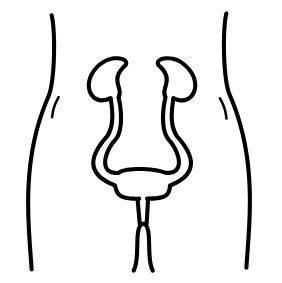 There is weak evidence from two studies that intermittent catheterization has the lowest risk of complications (such as urinary tract infections), followed by condom catheters. The highest risk of complications is with the use of indwelling catheters. Another study provides weak evidence that indwelling catheters are also related to higher risk of bladder cancer compared to other types of catheters.
There is weak evidence from two studies that intermittent catheterization has the lowest risk of complications (such as urinary tract infections), followed by condom catheters. The highest risk of complications is with the use of indwelling catheters. Another study provides weak evidence that indwelling catheters are also related to higher risk of bladder cancer compared to other types of catheters.
However, the choice of which type of catheterization to use is often related to many different factors, like level of injury and the type of bladder problems that a person has. For instance, another study found that for people with high-level tetraplegia, suprapubic catheters may lead to fewer complications than intermittent catheterization.
Additionally, the type of catheter equipment used for catheterization may also be important to reduce risk. There is strong evidence from a review of five studies that using lubricated (hydrophilic) catheters for intermittent catheterization reduces the risk of urinary tract infections compared to non-lubricated catheters.
Urinary catheters are the main method of emptying the bladder for people with bladder problems after SCI. There are several types of catheterization, with the most common being intermittent catheterization. The type of catheterization used depends on many factors, such as the type of neurogenic bladder, your risk of complications, level of independence, funding and lifestyle.
Research studies suggest that intermittent catheterization is the type of catheterization with the lowest risk of complications. For further information, it is important to discuss your treatment options with your health providers to find out which treatments are best for you.
For a review of how we assess evidence at SCIRE Community and advice on making decisions, please see SCIRE Community Evidence.
Hsieh J, McIntyre A, Iruthayarajah J, Loh E, Ethans K, Mehta S, Wolfe D, Teasell R. (2014). Bladder Management Following Spinal Cord Injury. In Eng JJ, Teasell RW, Miller WC, Wolfe DL, Townson AF, Hsieh JTC, Connolly SJ, Noonan VK, Loh E, McIntyre A, editors. Spinal Cord Injury Rehabilitation Evidence. Version 5.0: p 1-196.
Available from: https://scireproject.com/evidence/bladder-management/
Evidence for “How effective are urinary catheters for managing bladder problems after SCI?” is based on the following studies:
[1] Ord J, Lunn D, Reynard J. Bladder management and risk of bladder stone formation in spinal cord injured patients. Journal d’urologie 2003;170(5):1734-1737.
[2] Weld KJ, Dmochowski RR. Effect of bladder management on urological complications in spinal cord injured patients. J Urol 2000;163(3):768-772.
[3] Groah SL, Weitzenkamp DA, Lammertse DP, Whiteneck GG, Lezotte DC, Hamman RF. Excess risk of bladder cancer in spinal cord injury: evidence for an association between indwelling catheter use and bladder cancer. Arch Phys Med Rehabil 2002;83(3):346-351.
[4] Li L, Ye W, Ruan H, Yang B, Zhang S, Li L. Impact of hydrophilic catheters on urinary tract infections in people with spinal cord injury: Systematic review and meta-analysis of randomized controlled trials. Arch Phys Med Rehabil 2013;94(4):782-787.
Other References:
Cardenas DD, Hoffman JM. Hydrophilic catheters versus noncoated catheters for reducing the incidence of urinary tract infections: A randomized controlled trial. Arch Phys Med Rehabil 2009; 90:1668-1671.
Cardenas DD, Moore KN, Dannels-McClure A, Scelza WM, Graves DE, Brooks M et al. Intermittent catheterization with a hydrophilic-coated catheter delays urinary tract infections in acute spinal cord injury: A prospective, randomized, multicenter trial. PM R 2011; 3:408-417.
De Ridder DJ, Everaert K, Fernandez LG, Valero JV, Duran AB, Abrisqueta ML et al. Intermittent catheterisation with hydrophilic-coated catheters (SpeediCath) reduces the risk of clinical urinary tract infection in spinal cord injured patients: A prospective randomised parallel comparative trial. Eur Urol 2005; 48(6):991-995.
Giannantoni A, Di Stasi SM, Scivoletto G, Virgili G, Dolci S, Porena M. Intermittent catheterization with a prelubricated catheter in spinal cord injured patients: A prospective randomized crossover study. J Urol 2001; 166(1):130-133.
Groah SL, Weitzenkamp DA, Lammertse DP, Whiteneck GG, Lezotte DC, Hamman RF. Excess risk of bladder cancer in spinal cord injury: evidence for an association between indwelling catheter use and bladder cancer. Arch Phys Med Rehabil 2002; 83(3):346-351.
Hackler RH. Long-term Suprapubic cystostomy drainage in spinal cord injury patients. Br J Urol 1982; 54(2):120-121.
Moore KN, Burt J, Voaklander DC. Intermittent catheterization in the rehabilitation setting: A comparison of clean and sterile technique. Clin Rehabil 2006;20(6):461-468.
Ord J, Lunn D, Reynard J. Bladder management and risk of bladder stone formation in spinal cord injured patients. Journal d’urologie 2003; 170(5):1734-1737.
Perkash I, Kabalin JN, Lennon S, Wolfe V. Use of penile prostheses to maintain external condom catheter drainage in spinal cord injury patients. Paraplegia 1992; 30(5):327-332.
Prieto-Fingerhut T, Banovac K, Lynne CM. A study comparing sterile and nonsterile urethral catheterization in patients with spinal cord injury. Rehabil Nurs 1997;22(6):299-302.
van den Broek PJ, Wille JC, van Benthem BH, Perenboom RJ, van den Akker-van Marle ME, Niel-Weise BS. Urethral catheters: can we reduce use? BMC Urol 2011; 11:10.
Wyndaele JJ, De Taeye N. Early intermittent self-catheterisation after spinal cord injury. Paraplegia 1990; 28(2):76-80.
Yadav A, Vaidyanathan S, Panigrahi D. Clean intermittent catheterisation for the neuropathic bladder. Paraplegia 1993; 31(6):380-383.
Yavuzer G, Gok H, Tuncer S, Soygur T, Arikan N, Arasil T. Compliance with bladder management in spinal cord injury patients. Spinal Cord 2000; 38(12):762-765.
Image credits
- Urinary catheterization 01 ©Saltanat ebli, CC0 1.0
- Modified from: Urinary Sphincter ©BruceBlaus, CC BY-SA 4.0
- Calendar ©tezar tantular, CC BY 3.0 US
- Foley Catheter ©BruceBlaus, CC BY-SA 4.0
- Condom Cather Drainage ©BruceBlaus, CC BY-SA 4.0
- Modified from: Closed Urinary Drainage ©BruceBlaus, CC BY-SA 4.0
- Modified from: Empty the Urinary Drainage Bag ©BruceBlaus, CC BY-SA 4.0
- Bladder Stone 08783 ©Nevit Dilmen, CC BY-SA 3.0
- Excretory system ©Olena Panasovska, CC BY 3.0 US






